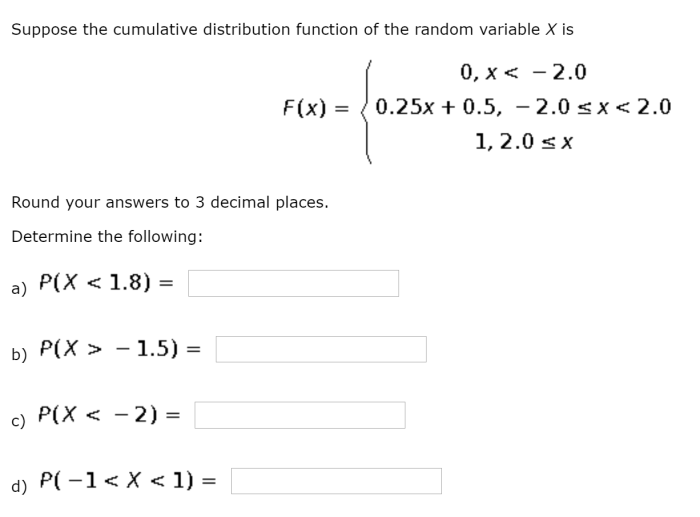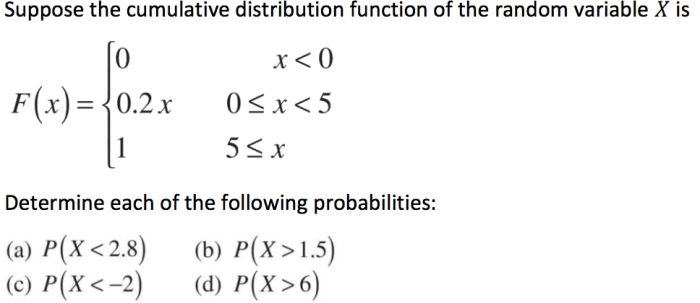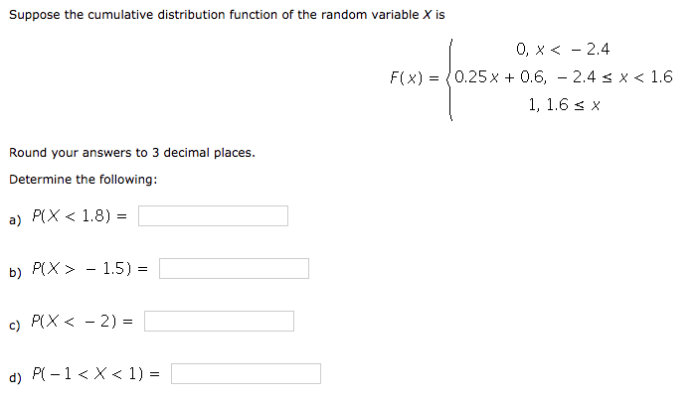Suppose the cumulative distribution of the random variable X is: A journey into the heart of probability and distributions, this comprehensive guide unveils the intricacies of a fundamental concept that underpins statistical analysis and decision-making.
Delving into the mathematical foundations of the cumulative distribution function (CDF), we explore its properties, applications, and methods of calculation. From determining probabilities to finding percentiles, the CDF serves as a versatile tool across diverse fields.
Definition and Introduction

The cumulative distribution function (CDF) of a random variable X is a function that gives the probability that X takes on a value less than or equal to a given value x.
Mathematically, the CDF of a random variable X is defined as:
$$F_X(x) = P(X ≤ x)$$
where P denotes the probability.
Applications of the CDF

The CDF can be used to determine probabilities of events involving the random variable X. For example, the probability that X takes on a value between a and b can be calculated as:
$$P(a < X ≤ b) = F_X(b) - F_X(a)$$
The CDF can also be used to find percentiles of the distribution of X. The pth percentile is the value x such that:
$$F_X(x) = p$$
Methods for Calculating the CDF
The CDF can be calculated using various methods, including:
- Integration: If the probability density function (PDF) of X is known, the CDF can be obtained by integrating the PDF.
- Table lookup: For some common distributions, such as the normal distribution, CDF values are available in tables.
- Software or online tools: Many statistical software packages and online tools provide functions for calculating CDFs.
Relationship between the CDF and the PDF
The CDF and the PDF of a random variable are closely related. The PDF can be obtained by differentiating the CDF:
$$f_X(x) = \fracdF_X(x)dx$$
Conversely, the CDF can be obtained by integrating the PDF:
$$F_X(x) = \int_-\infty^x f_X(t) dt$$
Examples of CDFs

The CDFs of some common distributions are:
- Normal distribution: $$F_X(x) = \frac1\sqrt2\pi\sigma^2 \int_-\infty^x e^-\frac(t-\mu)^22\sigma^2 dt$$
- Binomial distribution: $$F_X(x) = \sum_i=0^x \binomni p^i (1-p)^n-i$$
- Exponential distribution: $$F_X(x) = 1 – e^-\lambda x$$
Helpful Answers: Suppose The Cumulative Distribution Of The Random Variable X Is
What is the cumulative distribution function (CDF)?
The CDF is a function that gives the probability that a random variable X takes on a value less than or equal to a given value x.
How can the CDF be used to determine probabilities?
The CDF can be used to determine the probability that a random variable X takes on a value within a specified range.
What is the relationship between the CDF and the probability density function (PDF)?
The CDF and the PDF are related by the following equation: CDF(x) = ∫_-\infty^x PDF(t) dt.